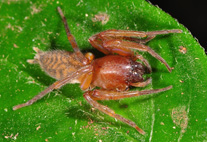Abstract
Elaver O. Pickard-Cambridge, 1898 is characterized and redescribed, including 49 species occurring from the United States to Argentina. Thirty seven previously known species are redescribed: Elaver achuca (Roddy, 1966) revalidated, E. balboae (Chickering, 1937), E. barroana (Chickering, 1937), E. calcarata (Kraus, 1955), E. carlota (Bryant, 1940), E. chisosa (Roddy, 1966), E. crinophora (Franganillo, 1934), E. crocota (O. Pickard-Cambridge, 1896), E. albicans (Franganillo, 1930) name restored, E. depuncta O. Pickard-Cambridge, 1898, E. elaver (Bryant, 1940), E. excepta (L. Koch, 1866), E. grandivulva (Mello-Leitão, 1930), E. hortoni (Chickering, 1937), E. implicata (Gertsch, 1941), E. juana (Bryant, 1940), E. kohlsi (Gertsch & Jellison, 1939), E. linguata (F.O. Pickard-Cambridge, 1900), E. madera (Roddy, 1966), E. mirabilis (O. Pickard-Cambridge, 1896) new. comb., E. mulaiki (Gertsch, 1935), E. multinotata (Chickering, 1937), E. orvillei (Chickering, 1937), E. placida O. Pickard-Cambridge, 1898, E. portoricensis (Petrunkevitch, 1930), E. quadrata (Kraus, 1955), E. richardi (Gertsch, 1941), E. sericea O. Pickard-Cambridge, 1898, E. sigillata (Petrunkevitch, 1925), E. simplex (O. Pickard-Cambridge, 1896), E. texana (Gertsch, 1933), E. tigrina O. Pickard-Cambridge, 1898 name restored, E. tricuspis (F.O. Pickard-Cambridge, 1900), E. tristani (Banks, 1909), E. tumivulva (Banks, 1909), E. valvula (F.O. Pickard-Cambridge, 1900) and E. wheeleri (Roewer, 1933). Ten new species are described: E. candelaria n. sp. and E. helenae n. sp. from Mexico; E. arawakan n. sp. from Haiti; E. lizae n. sp. from Costa Rica; E. darwichi n. sp. from Ecuador; E. juruti n. sp., E. tourinhoae n. sp. and E. vieirae n. sp. from Brazil; E. shinguito n. sp. from Peru and E. beni n. sp. from Bolivia. The female of E. hortoni is described for the first time. Lectotypes are designated for E. sigillata and its actual female is described for the first time. Four new synonyms are proposed: E. languida (Gertsch, 1941) is synonimized with E. multinotata; E. dorothea (Gertsch, 1935) with E. wheeleri; E. exempta (Gertsch & Davis, 1940) with E. placida and E. vulnerata (Kraus, 1955) with E. calcarata. The drawings in the original descriptions of E. kawitpaaia (Barrion & Litsinger, 1995) and E. turongdaliriana (Barrion & Litsinger, 1995) are sufficiently informative to exclude these species from Elaver but not to accurately establish its generic affiliation. Thus, until the types become available for examination, these species must remain as Clubionidae incertae sedis. Heterochemmis (F.O. Pickard-Cambridge, 1900) is synonymized with Elaver and Heterochemmis mutatus Gertsch & Davis,1940 is recognized as a junior synonym of Elaver mirabilis n. comb., the type species of Heterochemmis. New records are presented for E. valvula, E. balboae, E. brevipes (Keyserling, 1891), E. grandivulva and E. lutescens (Schmidt, 1971). Two species described by Franganillo, E. tenera (Franganillo, 1935) and E. tenuis (Franganillo, 1935), are considered species inquirendae.

